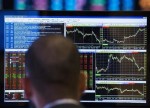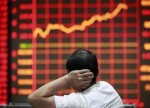
- All Instrument Types
- Indices
- Equities
- ETFs
- Funds
- Commodities
- Currencies
- Crypto
- Bonds
- Certificates
Please try another search

Market Wrap: Trading Inside the Expanding Rings of the AI Superstorm

AI’s footprint is no longer something you can confine to a handful of hyperscalers any more than you can confine a monsoon to a single coastline. What started as a neatly framed Silicon Valley boom is now a barometric shift across the entire S&P 500 — a structural repricing that Asia wakes up to every morning as if adjusting to a new atmospheric pressure.
The GPU temples are still the shrines traders pray toward at dawn, but the market’s real metamorphosis is happening in the expanding rings of influence radiating out from that core.
The first ring is the great industrial undercarriage of the AI Manhattan Project. You can almost see it in the tape before it shows up in the earnings: data-center REITs suddenly trading like duration assets; power-grid infrastructure names capturing multi-year visibility they haven’t seen in decades; electrical-equipment manufacturers — breakers, cabling, switching gear, cooling systems — behaving like they’ve stumbled into a secular rerating without changing a single product line.
These are companies Wall Street once valued by flipping to the back page of the model; now they’re being valued like irreplaceable bottlenecks in a $5 trillion capex supercycle. It’s the stealthiest form of breadth: old lines turning into growth lines because AI physically needs what they build.
Then there’s the second ring — the semiconductor ecosystem beyond the usual GPU royalty. This is where the reshuffling of the hierarchy gets interesting. Memory vendors, substrate suppliers, packaging specialists, analog power-management designers, and lithography titans like ASML (NASDAQ:ASML) and the constellation of its sub-vendors have become structural beneficiaries of compute density.
You don’t trade DRAM cycles anymore; you trade AI-capacity cycles. It’s not “Nvidia’s (NASDAQ:NVDA) quarter” — it’s a persistent global shortage of the entire computational stack, from HBM to power circuitry. This is how breadth forms through supply-chain diffusion: not because the market decides to buy more names, but because the physics of AI requires more names.
But the third ring — the enterprise layer — is where the next leg of AI breadth gets written. This is where the baton passes from “we sell GPUs” to “we use AI internally,” and the earnings impact becomes diffuse, cumulative, and quietly powerful. The software titans, cybersecurity firms, cloud-integrated service providers, healthcare analytics platforms, logistics operators, even consumer-facing companies — they don’t need to announce a moonshot.
They just need a few percentage points of structural margin uplift from automated workflows, AI-driven customer service, predictive risk engines, or optimized supply chains. This is how the productivity dividend creeps in: not loudly, not suddenly, but through a thousand incremental improvements. In a high-rate world, margin efficiency is the new growth factor — and AI is the oxygen tank.
And finally comes the outer ring, the part of the story almost no one models properly: the spillover into the real economy — copper demand, power-grid reinforcement, transformer bottlenecks, energy-intensity upgrades, construction, permitting, and regional industrial buildouts. This is where Asia is becoming less a spectator and more a participant.
Taiwan, Korea, Japan, and increasingly Southeast Asia are all being pulled into the global AI supply lattice. From chip manufacturing to EV battery plants to grid-scale infrastructure, the region’s fortunes are tethered to the same structural current that’s reshaping the S&P 500. AI isn’t a tech cycle; it’s an economic rewiring cycle. And rewiring cycles don’t stay narrow — they broaden because they must.
So when we talk about AI breadth, we’re not talking about “will the S&P 493 finally catch a bid?” We’re talking about the gradual absorption of entire sectors into the AI gravity field — industrials turning into capex utilities, utilities turning into power-tech hybrids, software turning into automated margin-machines, and semis turning into capital equipment toll roads. AI has stopped being a storyline. It has become the scaffolding of 21st-century corporate profitability. And Asia trades inside that scaffolding every single day, whether Tokyo is catching a downtick in 30-year JGBs, Korea is front-running memory cycles, or Taiwan is pricing geopolitical risk like a volatility tax.
The market still frames AI as a sector. But AI is already behaving like a meta-factor — as pervasive as globalization, as economically distorting as the smartphone era, and as essential as electricity. That’s why the influence won’t stop at the hyperscalers. It will sweep across the entire S&P 500, not in a single surge, but in expanding rings — each one pulling in another set of companies, another sector, another region. The breadth isn’t coming. The breadth is already here. It’s just arriving in the subtle, cumulative, capex-heavy fashion that this new world trades on.
Related Articles

The retail sales report was disappointing and below economists’ consensus estimate of a 0.3% increase, so this may help coax the Fed to cut key interest rates on December...

Value-focused retailers like Walmart and TJX are thriving as consumers cut back on discretionary items and trade down from mid-tier stores. Despite near-record low consumer...

Alphabet (NASDAQ:GOOGL) has emerged as one of the few major tech names defying the recent pullback in artificial intelligence equities. While several AI leaders have faced heavy...
Are you sure you want to block %USER_NAME%?
By doing so, you and %USER_NAME% will not be able to see any of each other's Investing.com's posts.
%USER_NAME% was successfully added to your Block List
Since you’ve just unblocked this person, you must wait 48 hours before renewing the block.
I feel that this comment is:
Thank You!
Your report has been sent to our moderators for review




Add a Comment
We encourage you to use comments to engage with users, share your perspective and ask questions of authors and each other. However, in order to maintain the high level of discourse we’ve all come to value and expect, please keep the following criteria in mind:
Perpetrators of spam or abuse will be deleted from the site and prohibited from future registration at Investing.com’s discretion.